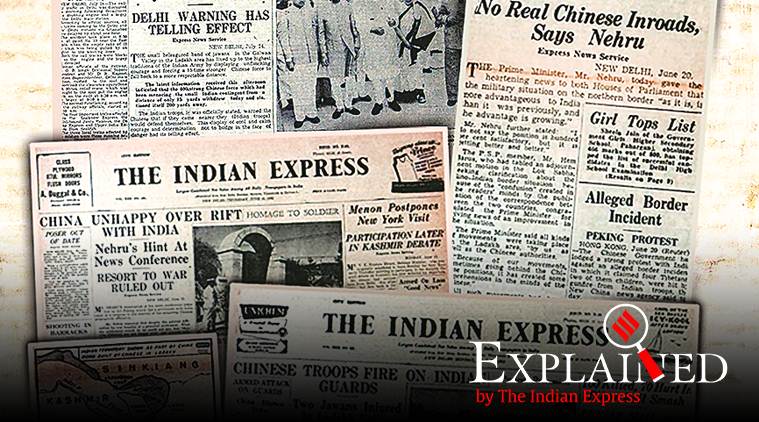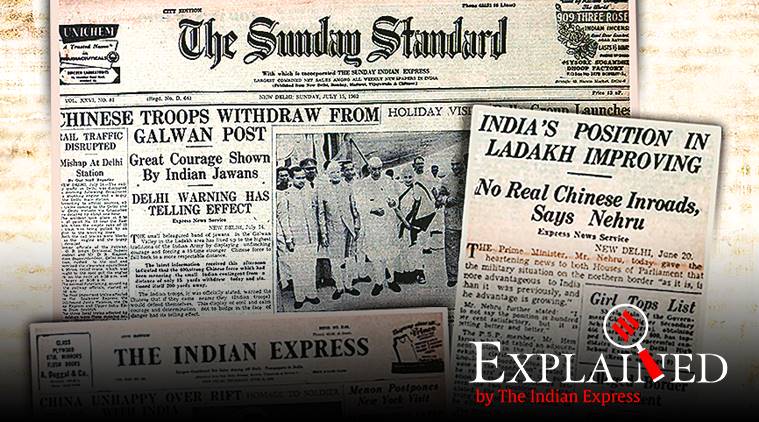Written by
Man Aman Singh Chhina | Chandigarh | Updated: July 10, 2020 10:56:16 am
 Archives of The Indian Express from 1962 reflect how tensions unfolded in the same areas of Ladakh, particularly Galwan, that have been in the news in the last two months. (Archive)
Archives of The Indian Express from 1962 reflect how tensions unfolded in the same areas of Ladakh, particularly Galwan, that have been in the news in the last two months. (Archive)In July 58 years ago, Indian and Chinese troops were taking steps towards disengagement on the Line of Actual Control. On July 15, 1962, The Sunday Standard ran its front-page lead report with the headline ‘Chinese Troops Withdraw From Galwan Post’. And on July 8, 2020, The Indian Express headline on the current steps towards disengagement ran: ‘After Galwan Valley, troops on both sides start pulling back in Hot Springs sector’.
Archives of The Indian Express from 1962 reflect how tensions unfolded in the same areas of Ladakh, particularly Galwan, that have been in the news in the last two months.
June 12, 1962
China has charged India with setting up Army posts on its territory; India denies it.
Report: The Indian Express reports the government’s rejection of the Chinese assertion that the Indian Army has set up two new posts in Sinkiang-Uighur of Chinese territory. It says India has protested against establishment of a post in Chip-Chap river and that China had ordered aggressive patrolling by its forces from Karakoram Pass on one end of the border to Kongka La on the other.
 The Indian Express headline on the current steps towards disengagement ran: ‘After Galwan Valley, troops on both sides start pulling back in Hot Springs sector’.
The Indian Express headline on the current steps towards disengagement ran: ‘After Galwan Valley, troops on both sides start pulling back in Hot Springs sector’.June 14, 1962
Prime Minister Jawaharlal Nehru says Chinese have entered Indian territory.
Report: The headline notes that the PM rules out war and also that China is ‘unhappy over rift with India’. Nehru is quoted as saying that “they (China) are not happy with our present relations”. The PM also says the Chinese have crossed into large chunks of Indian territory in Ladakh.
June 20, 1962
Notes are exchanged over incursions in Ladakh and NEFA
Report: ‘India’s Defences No Menace to Chinese’, says the headline, adding that the Chinese charges of intrusion in Ladakh have been repudiated by India. The report highlights the government’s statement to China about incursions in Ladakh as well as a village in the eastern sector, along with the fact that India and China have “exchanged notes”.
June 21, 1962
Nehru’s statement in Parliament about situation getting better in Ladakh
Report: Front page reports PM’s speech that the military situation on the northern borders is more advantageous to India than it was previously “and the advantage is growing”. It quotes Nehru as saying, “I do not say the position is hundred percent satisfactory, but it is getting better and better”.
June 23, 1962
India reiterates it will not accept Chinese demands to withdraw posts in Daulat Beg Oldie, asks for mutual withdrawal of forces
Report: Headline declares ‘India Not To Abandon Posts in Ladakh’; ‘Armed Clash Threat By Peking Deplored’. The report quotes Nehru as saying that a fear complex has gripped China. The then Deputy External Affairs Minister, Dinesh Singh, is quoted as saying that India had asked China for mutual withdrawal of forces in a note dated May 14.
📢 Express Explained is now on Telegram. Click here to join our channel (@ieexplained) and stay updated with the latest
July 11, 1962
Indian Army post in Galwan valley is surrounded by Chinese troops
Report: It refers to a post in Galwan valley surrounded by 400 Chinese troops. It notes that the lower reaches are not only well inside Indian territory but also 28 miles from the claim line shown by the Chinese 1956 map about which Premier Chou En Lai had written to Nehru on November 17, 1959. Referring to a Chinese memorandum of June 8, the Indian government is quoted as saying, “If as claimed in the Chinese memorandum, the Chinese troops have infiltrated and set up a post in the lower reaches of Galwan river it is a serious violation of Indian territory. It must be vacated.”
July 12, 1962
Ministry of External Affairs says Indian troops will retaliate if attacked in Ladakh
Report: A map of the Northern borders is published on the front page, with a cross marking Galwan valley position encircled by the Chinese. “Should the Chinese attack the Indian Post here, the Indian forces will retaliate appropriately,” a Ministry of External Affairs spokespeson is quoted as saying.
July 14, 1962
Chinese troops tighten encirclement; India warns of firing in self-defence
Report: ‘China Warned Against New Moves in Galwan’ reads the headline. Report quotes the Indian government as saying the Chinese troops are now only 50-70 yards from Indian troops in Galwan post.
July 15, 1962
Chinese troops withdraw some distance from the Indian post
Report: It quotes officials as saying that great courage was shown by Indian jawans in the face of Chinese troops 15 times stronger and that the warning delivered by Delhi to China had a telling effect. Asked if there will be a major clash, Nehru is quoted as saying, “There is a risk of clash but not a major one”. Another report states the government’s position that Aksai Chin was never part of China.
July 16, 1962
Nehru praises tenacity of Army jawans
Report: ‘Nehru Happy at Chinese Withdrawal.’ The headline adds, ‘No Wish To Provoke Shooting in Galwan’. Report says Nehru praises jawans guarding the frontiers.
July 17, 1962
Chinese troops withdraw 200 yards from Indian post in Galwan; China complain of Indian posts in Pangong Lake area
Report: Headline notes the situation is still tense. An MEA spokesperson is quoted as saying the Chinese have withdrawn 200 yards and are 400 in number. Another report notes that the Chinese have alleged that India has set up three posts at Sirijap on the banks of Pangong Lake about 2 km inside Chinese territory, at Yula on the Southern bank of the lake “over ten km within China”, and northwest of Nyugzu “about five km within China”.
July 23, 1962
First incidents of firing since 1959 Hot Springs incident
Report: The headline notes Chinese troops have fired on Indian guards and two jawans have been injured in Ladakh valley. The report says the “Indian party exercised restraint and did not fire back” in Pangong area. At Chip Chap river, an Indian patrol was attacked with light machine guns, rifles and two-inch mortars and this time returned fire.
July 25, 1962
Chinese troops attempt to sever Indian lines of communication and supply to Galwan post
Report: ‘Chinese Bid to Set Up Base in Galwan’ — the report says the government has urged that Chinese forces stop interfering with the communication and supplies to the Indian post and withdraw peacefully.
August 23, 1962
India sets terms for talks, sends fresh troops to relieve those at Galwan post
Report: The headline reads ‘Border Talks Only If Aggression Is Vacated’. Nehru is quoted as saying Galwan garrison would be relieved soon by a column sent by road.
September 13, 1962
Focus shifts to NEFA as Chinese launch full-scale invasion across MacMohan Line
Report: The headline states ‘Chinese Troops Advance into NEFA’. The report says Delhi is rushing forces.
Hereafter, developments in the Northeast would take centrestage. On October 19, 1962 the Chinese launched an offensive in Ladakh and took over Chip Chap valley, Galwan valley and posts in Pangong.







 The Indian Express headline on the current steps towards disengagement ran: ‘After Galwan Valley, troops on both sides start pulling back in Hot Springs sector’.
The Indian Express headline on the current steps towards disengagement ran: ‘After Galwan Valley, troops on both sides start pulling back in Hot Springs sector’.